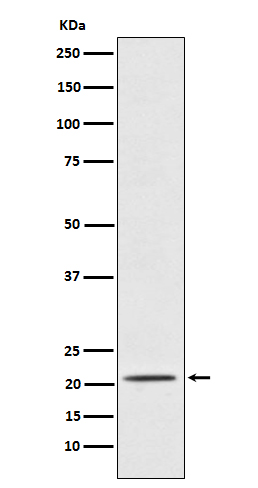Placental Protein 14 / PAEP Antibody
Rabbit mAb
- SPECIFICATION
- CITATIONS
- PROTOCOLS
- BACKGROUND

Application
| WB |
|---|---|
| Primary Accession | P09466 |
| Clonality | Monoclonal |
| Other Names | GdA; GdF; GdS; Glycodelin A; Glycodelin; Glycodelin F; Glycodelin S; PAEG; PAEP; PEG; PEP; Placental protein 14; PP14; |
| Isotype | Rabbit IgG |
| Host | Rabbit |
| Calculated MW | 20624 Da |
| Dilution | WB 1:500~1:2000 |
|---|---|
| Purification | Affinity-chromatography |
| Immunogen | A synthesized peptide derived from human Placental Protein 14 / PAEP |
| Description | This protein is, quantitatively, the main protein synthesized and secreted in the endometrium from mid-luteal phase of the menstrual cycle and during the first semester of pregnancy. |
| Storage Condition and Buffer | Rabbit IgG in phosphate buffered saline , pH 7.4, 150mM NaCl, 0.02% sodium azide and 50% glycerol. Store at +4°C short term. Store at -20°C long term. Avoid freeze / thaw cycle. |
| Name | PAEP |
|---|---|
| Function | Glycoprotein that regulates critical steps during fertilization and also has immunomonomodulatory effects. Four glycoforms, namely glycodelin-S, -A, -F and -C have been identified in reproductive tissues that differ in glycosylation and biological activity. Glycodelin-A has contraceptive and immunosuppressive activities (PubMed:7531163, PubMed:9918684). Glycodelin-C stimulates binding of spermatozoa to the zona pellucida (PubMed:17192260). Glycodelin-F inhibits spermatozoa-zona pellucida binding and significantly suppresses progesterone-induced acrosome reaction of spermatozoa (PubMed:12672671). Glycodelin-S in seminal plasma maintains the uncapacitated state of human spermatozoa (PubMed:15883155). |
| Cellular Location | Secreted |
| Tissue Location | This protein is, the main protein synthesized and secreted in the endometrium from mid-luteal phase of the menstrual cycle and during the first semester of pregnancy (PubMed:3667877) Glycodelin-A is expressed in amniotic fluid, endometrium/decidua and maternal serum (at protein level) (PubMed:3194393). Glycodelin-F is expressed in follicular fluid, luteinized granulosa cells and the oviduct (at protein level) (PubMed:12672671). Glycodelin-S is expressed in seminal plasma and seminal vesicles (at protein level) (PubMed:9239694). Glycodelin-C is detected in cumulus cells (at protein level), but cumulus cells do not synthesize Glycodelin-C but take up and convert glycodelin-A and -F vis glycan remodeling (PubMed:17192260). |

Thousands of laboratories across the world have published research that depended on the performance of antibodies from Abcepta to advance their research. Check out links to articles that cite our products in major peer-reviewed journals, organized by research category.
info@abcepta.com, and receive a free "I Love Antibodies" mug.
Provided below are standard protocols that you may find useful for product applications.
If you have used an Abcepta product and would like to share how it has performed, please click on the "Submit Review" button and provide the requested information. Our staff will examine and post your review and contact you if needed.
If you have any additional inquiries please email technical services at tech@abcepta.com.













 Foundational characteristics of cancer include proliferation, angiogenesis, migration, evasion of apoptosis, and cellular immortality. Find key markers for these cellular processes and antibodies to detect them.
Foundational characteristics of cancer include proliferation, angiogenesis, migration, evasion of apoptosis, and cellular immortality. Find key markers for these cellular processes and antibodies to detect them. The SUMOplot™ Analysis Program predicts and scores sumoylation sites in your protein. SUMOylation is a post-translational modification involved in various cellular processes, such as nuclear-cytosolic transport, transcriptional regulation, apoptosis, protein stability, response to stress, and progression through the cell cycle.
The SUMOplot™ Analysis Program predicts and scores sumoylation sites in your protein. SUMOylation is a post-translational modification involved in various cellular processes, such as nuclear-cytosolic transport, transcriptional regulation, apoptosis, protein stability, response to stress, and progression through the cell cycle. The Autophagy Receptor Motif Plotter predicts and scores autophagy receptor binding sites in your protein. Identifying proteins connected to this pathway is critical to understanding the role of autophagy in physiological as well as pathological processes such as development, differentiation, neurodegenerative diseases, stress, infection, and cancer.
The Autophagy Receptor Motif Plotter predicts and scores autophagy receptor binding sites in your protein. Identifying proteins connected to this pathway is critical to understanding the role of autophagy in physiological as well as pathological processes such as development, differentiation, neurodegenerative diseases, stress, infection, and cancer.


